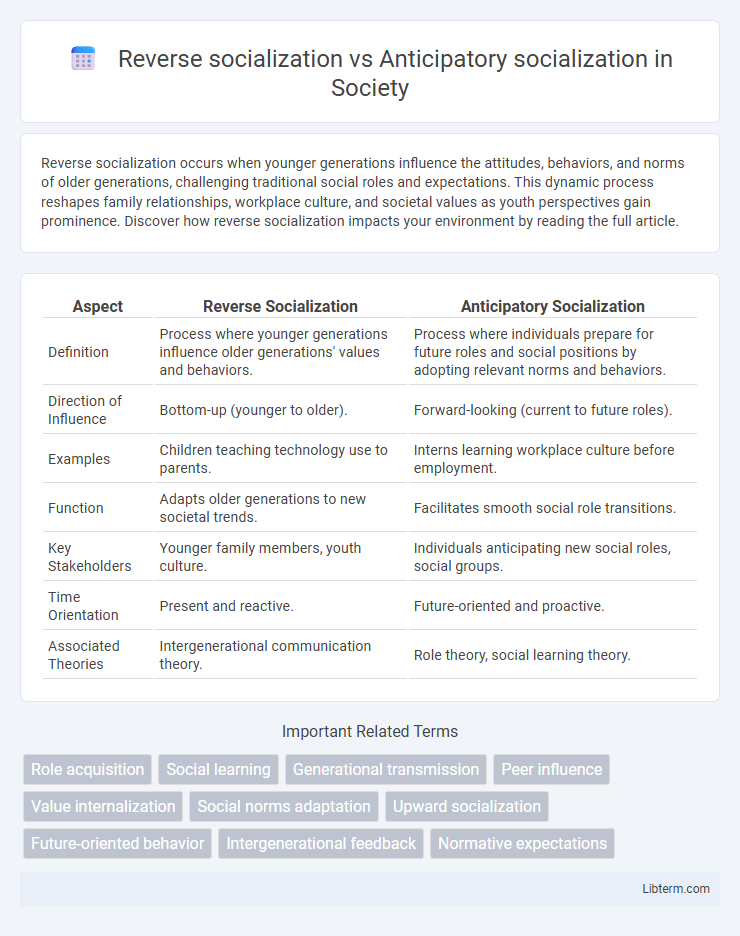Reverse socialization occurs when younger generations influence the attitudes, behaviors, and norms of older generations, challenging traditional social roles and expectations. This dynamic process reshapes family relationships, workplace culture, and societal values as youth perspectives gain prominence. Discover how reverse socialization impacts your environment by reading the full article.
Table of Comparison
| Aspect | Reverse Socialization | Anticipatory Socialization |
|---|---|---|
| Definition | Process where younger generations influence older generations' values and behaviors. | Process where individuals prepare for future roles and social positions by adopting relevant norms and behaviors. |
| Direction of Influence | Bottom-up (younger to older). | Forward-looking (current to future roles). |
| Examples | Children teaching technology use to parents. | Interns learning workplace culture before employment. |
| Function | Adapts older generations to new societal trends. | Facilitates smooth social role transitions. |
| Key Stakeholders | Younger family members, youth culture. | Individuals anticipating new social roles, social groups. |
| Time Orientation | Present and reactive. | Future-oriented and proactive. |
| Associated Theories | Intergenerational communication theory. | Role theory, social learning theory. |
Introduction to Socialization Processes
Reverse socialization occurs when younger generations influence the attitudes, behaviors, and knowledge of older generations, reversing the typical flow of social learning. Anticipatory socialization involves individuals preparing for future roles, norms, or statuses by adopting behaviors and attitudes of a group they aspire to join. Both processes are fundamental in understanding the dynamic nature of socialization, highlighting how social roles and expectations are transmitted and adapted across generations.
Defining Reverse Socialization
Reverse socialization occurs when younger generations influence the values, behaviors, or knowledge of older generations, reversing the traditional socialization flow. In contrast, anticipatory socialization involves individuals preparing for future roles by adopting relevant norms and behaviors in advance. Understanding reverse socialization highlights how technology, cultural shifts, and new information often lead younger people to educate or reshape perspectives of their elders.
Understanding Anticipatory Socialization
Anticipatory socialization involves individuals adopting behaviors, values, and norms of a group they aspire to join, enabling smoother integration and role adaptation in future social contexts. This process contrasts with reverse socialization, where younger generations influence and modify the attitudes or behaviors of older generations. Understanding anticipatory socialization highlights its role in preparing individuals for upcoming social roles, enhancing social cohesion and personal development within evolving societal structures.
Key Differences Between Reverse and Anticipatory Socialization
Reverse socialization occurs when younger generations influence and modify the behaviors, attitudes, or values of older generations, while anticipatory socialization involves individuals adopting behaviors or roles in preparation for future social positions. The key differences lie in the direction of influence--reverse socialization flows from younger to older generations, whereas anticipatory socialization is proactive and self-directed toward future adaptation. Reverse socialization often challenges established norms, whereas anticipatory socialization aims at smoother integration into anticipated social roles.
Agents of Reverse Socialization
Agents of reverse socialization primarily include children, media, and technology, which influence older generations by introducing new cultural norms, behaviors, and technological skills. Unlike anticipatory socialization, where individuals prepare for future roles, reverse socialization involves younger individuals shaping the attitudes and knowledge of adults. Family members and digital platforms play crucial roles in facilitating this upward exchange of socialization.
Agents of Anticipatory Socialization
Agents of anticipatory socialization include family, peers, educational institutions, and media, which actively prepare individuals for future roles and social positions. These agents transmit values, norms, and behaviors expectations, enabling individuals to adopt the mindset and skills required for anticipated statuses. Unlike reverse socialization, where younger generations influence older ones, anticipatory socialization is forward-looking and centered on adapting to upcoming social environments.
Real-World Examples of Reverse Socialization
Reverse socialization occurs when younger generations influence older generations with new technology, trends, or social norms, such as teenagers teaching their parents how to navigate social media platforms like Instagram or TikTok. In contrast, anticipatory socialization involves individuals preparing for future roles or statuses, like interns adopting workplace behaviors before full employment. Real-world examples of reverse socialization include grandparents learning smartphone usage and digital communication from their grandchildren, highlighting the dynamic flow of cultural knowledge across age groups.
Practical Instances of Anticipatory Socialization
Anticipatory socialization occurs when individuals adopt behaviors and norms of a group they aspire to join, such as interns practicing corporate etiquette before full employment or students wearing professional attire during career fairs to fit industry expectations. Practical instances include medical students shadowing doctors to internalize professional roles or new employees undergoing training programs that simulate workplace culture. These preparatory experiences contrast with reverse socialization, where younger generations influence older ones, often observed in technology adoption within families.
Impact on Identity and Cultural Change
Reverse socialization occurs when younger generations influence older ones, reshaping identities and cultural norms by introducing new values and behaviors, while anticipatory socialization prepares individuals for future roles by adopting norms and behaviors in advance, which gradually solidifies identity and cultural expectations. The impact of reverse socialization often triggers rapid cultural change and challenges traditional identity frameworks, whereas anticipatory socialization promotes smoother transitions and continuity in cultural identity. Both processes play critical roles in the dynamic evolution of social identities and cultural transformations within societies.
Conclusion: The Evolving Nature of Socialization
Reverse socialization highlights how younger generations influence older ones, while anticipatory socialization prepares individuals for future roles and expectations. Both processes demonstrate the dynamic and reciprocal nature of social learning, adapting constantly to societal changes and technological advancements. This evolving nature of socialization underscores its critical role in shaping identities and social roles across different contexts and generations.
Reverse socialization Infographic

 libterm.com
libterm.com